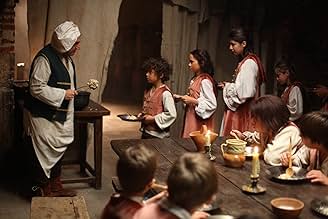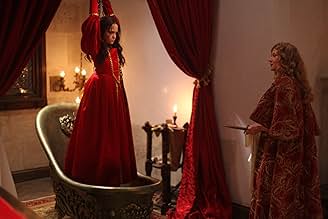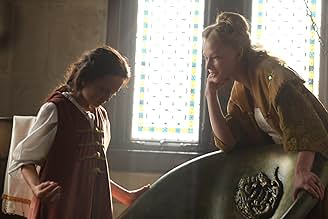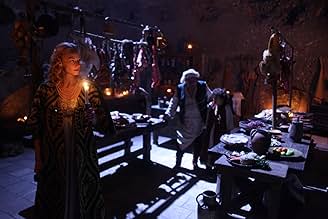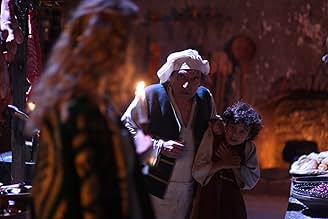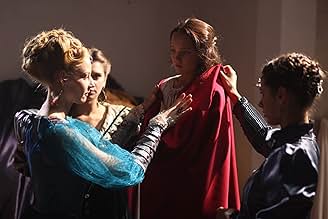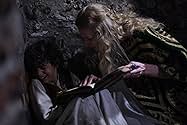AVALIAÇÃO DA IMDb
4,1/10
795
SUA AVALIAÇÃO
Adicionar um enredo no seu idiomaBased on a story of Countess Bathory, a serial killer in 16th century Transylvania who supposedly killed hundreds of children.Based on a story of Countess Bathory, a serial killer in 16th century Transylvania who supposedly killed hundreds of children.Based on a story of Countess Bathory, a serial killer in 16th century Transylvania who supposedly killed hundreds of children.
- Prêmios
- 1 indicação no total
Paul Octavian Diaconescu
- Lazlo
- (as Paul Diaconescu)
Avaliações em destaque
I have seen a couple attempts at putting the so-called Blood Countess on films. For instance The Countess with Julie Delpy, has fine acting, but is very slow and wants me to over identify with the countess and empathize with her.
This movie at least offers better production values, non-terrible child actors that you can root for and at least a nod in the direction of historical accuracy. (The one thing I am unclear on historically is any evidence that she might have killed any significant numbers of young boys. Her treatment of young girls is reasonably well-documented.)
So while it is a bit cheesy and overdramatic at times, it has much more going for it, than many adaptations of this historical tale. The actress playing the countess is also quite good at projecting a certain mixture of menacing intensity overlaid with a nonthreatening approachable veneer. Also these resourceful gypsy kid protagonists are great. Some small bits of it are predictable enough, but there a few surprises to hold your interest.
I'm not saying this should top any horror movie lists, but it certainly shouldn't be tossed at the bottom of the horror barrel with Asylum films either.
This movie at least offers better production values, non-terrible child actors that you can root for and at least a nod in the direction of historical accuracy. (The one thing I am unclear on historically is any evidence that she might have killed any significant numbers of young boys. Her treatment of young girls is reasonably well-documented.)
So while it is a bit cheesy and overdramatic at times, it has much more going for it, than many adaptations of this historical tale. The actress playing the countess is also quite good at projecting a certain mixture of menacing intensity overlaid with a nonthreatening approachable veneer. Also these resourceful gypsy kid protagonists are great. Some small bits of it are predictable enough, but there a few surprises to hold your interest.
I'm not saying this should top any horror movie lists, but it certainly shouldn't be tossed at the bottom of the horror barrel with Asylum films either.
Loosely based on the story of Elizabeth Bathory, almost turning it into a fairytale. I have no problem with such an approach, but there are some serious plot holes in this story. Sometimes you wonder why is this character doing this and why this man is with this woman, when they should be enemies, not a couple... (I'm avoiding putting spoilers, so no more details).
The setting is splendid - Corvin Castle in Transylvania. Much bigger than the actual castle of Elizabeth Bathory (I've visited both). The costumes are fine. The acting probably not so good. It's not a disaster, though.
Overall, probably among the better films about Bathory in recent years.
The setting is splendid - Corvin Castle in Transylvania. Much bigger than the actual castle of Elizabeth Bathory (I've visited both). The costumes are fine. The acting probably not so good. It's not a disaster, though.
Overall, probably among the better films about Bathory in recent years.
From the cheap wigs to the awful acting, I cannot express this enough: it was a total waste of time. Don't watch it, plain simple.
You're welcome.
You're welcome.
It's a tale about two gypsy orphans who find themselves in the care of the Countess. This movie is much better than I expected.
The gaps in this movie are about as wide as the Grand Canyon! For starters Csejte Castle is not located in Transylvania, but in northeastern Slovakia! The castle shown in this film is Hunyadvara, which never belonged to the Báthory estates! While the Báthory family had roots in Transylvania, she never lived there. Secondly Erzsébet Báthory never killed anyone or had anyone tortured to death!
The Báthory family was very interesting to say the least! The Báthory family, which had played an important part in Hungarian history since the 13th and 14th centuries, had several distinct branches, including those of Somlya and Ecsed. One of these branches had given Transylvania its princes, including István Báthory who would later become one of the most highly respected monarchs of Poland. István's sister Anna Báthory of Somlya would marry György Báthory of Ecsed; their children were Erzsébet and her brother, hymn writer and judge István. Erzsébet's cousin Zsigmond and nephew Gábor would also become Princes of Transylvania and play important parts in the case surrounding her.
In plain English Erzsébet was a very rich and powerful woman! In fact rich enough that she could support any rebellion against the Hapsburg King of Hungary. A trumped up charges was introduced against her by György Thurzó, the Palatine of Hungary and ally of the King Matthias II. As Palatine, he was therefore committed to Matthias II's political strategy against Gábor Báthory the Prince of Transylvania, a relative of Erzsébet. The charges were made up and based upon lies in order to confiscate her properties and ruin the Báthorys of Transylvania and the Nádasdys of Hungary. Erzsébet. Was married to Count Nádasdy at an early age, and their son took a part in a rebellion against the Hapsburgs.
Even though the trial investigation was painstakingly extensive, it failed to turn up any concrete evidence to prove Countess Báthory's guilt in shedding the blood and snuffing out the lives of hundreds of victims. It did, however, contain numerous signs of a show trial: the construction of forged evidence, the dissemination of false rumors, and the use of horror stories to intimidate and manipulate witnesses. As she was of Noble birth she could not be executed, only her servants were, in punishment of her unproven crimes she was mot allowed to live her castle, the only estate she was allowed to keep. During her trial, the countess was never permitted to speak for herself, nor was anyone else allowed to testify on her behalf. Following their torture and interrogation, all but one of Erzsébet's personal servants were executed. Imprisoned for life, Erzsébet Báthory would survive the day of her arrest only by four years; she died on 21 August 1614. Thus this was not about horrific crimes that she allegedly committed but about politics, wealth and power.
Thus this film is just based upon BS and myths.
The Báthory family was very interesting to say the least! The Báthory family, which had played an important part in Hungarian history since the 13th and 14th centuries, had several distinct branches, including those of Somlya and Ecsed. One of these branches had given Transylvania its princes, including István Báthory who would later become one of the most highly respected monarchs of Poland. István's sister Anna Báthory of Somlya would marry György Báthory of Ecsed; their children were Erzsébet and her brother, hymn writer and judge István. Erzsébet's cousin Zsigmond and nephew Gábor would also become Princes of Transylvania and play important parts in the case surrounding her.
In plain English Erzsébet was a very rich and powerful woman! In fact rich enough that she could support any rebellion against the Hapsburg King of Hungary. A trumped up charges was introduced against her by György Thurzó, the Palatine of Hungary and ally of the King Matthias II. As Palatine, he was therefore committed to Matthias II's political strategy against Gábor Báthory the Prince of Transylvania, a relative of Erzsébet. The charges were made up and based upon lies in order to confiscate her properties and ruin the Báthorys of Transylvania and the Nádasdys of Hungary. Erzsébet. Was married to Count Nádasdy at an early age, and their son took a part in a rebellion against the Hapsburgs.
Even though the trial investigation was painstakingly extensive, it failed to turn up any concrete evidence to prove Countess Báthory's guilt in shedding the blood and snuffing out the lives of hundreds of victims. It did, however, contain numerous signs of a show trial: the construction of forged evidence, the dissemination of false rumors, and the use of horror stories to intimidate and manipulate witnesses. As she was of Noble birth she could not be executed, only her servants were, in punishment of her unproven crimes she was mot allowed to live her castle, the only estate she was allowed to keep. During her trial, the countess was never permitted to speak for herself, nor was anyone else allowed to testify on her behalf. Following their torture and interrogation, all but one of Erzsébet's personal servants were executed. Imprisoned for life, Erzsébet Báthory would survive the day of her arrest only by four years; she died on 21 August 1614. Thus this was not about horrific crimes that she allegedly committed but about politics, wealth and power.
Thus this film is just based upon BS and myths.
Você sabia?
- CuriosidadesAlso known as "The Blood Queen" (Amazon Prime)
- ConexõesVersion of Os Vampiros (1957)
Principais escolhas
Faça login para avaliar e ver a lista de recomendações personalizadas
- How long is Lady of Csejte?Fornecido pela Alexa
Detalhes
Bilheteria
- Faturamento bruto mundial
- US$ 937.955
- Tempo de duração1 hora 46 minutos
- Cor
Contribua para esta página
Sugerir uma alteração ou adicionar conteúdo ausente



